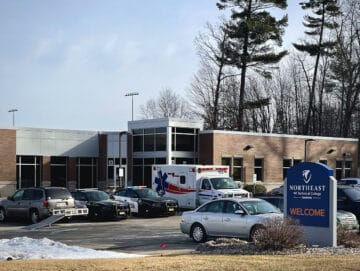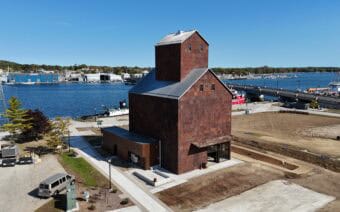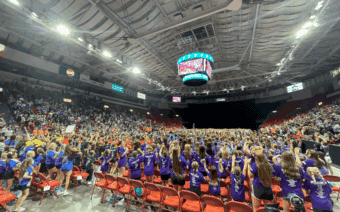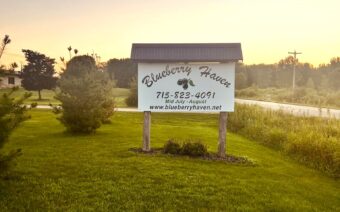
March 20, 2024
OSHKOSH — In celebration of its 100th year and to help usher in the next 100 years of service to the Oshkosh and Lake Winnebago areas, the Oshkosh Public Museum (OPM) recently unveiled its new logo and visual identity.
Sarah Phillips, OPM director, said there were some things about the previous logo staff thought were important to keep, but OPM’s new logo drew inspiration from two things unique to Oshkosh: the sunrise over Lake Winnebago and the rich jewel tones found in the Tiffany stained glass landscape window in the Sawyer home.
“We all sat down together about a year ago and talked about what it was about the current logo (at that time) we liked and where we wanted to have an opportunity to change things,” she said. “One of the things everybody seemed to enjoy about the (existing) logo was that it was a strong nod to the natural landscape of the Lake Winnebago region and Oshkosh.”
Additionally, Phillips said the museum, located at 1331 Algoma Blvd., wanted the new logo to incorporate its new mission.
“Our mission expanded last year to encompass not just history but history, art and culture,” she said. “When we were talking about redesigning the logo, we wanted something a bit more flexible and less literal to the natural landscape we could use in different ways, but would still (demonstrate) a strong tie to the landscape and the world around us.”
Phillips said graphic artist Daniel Fiser helped with the logo design.
“Daniel has a strong background in different (types of) marketing and logo development, so we were able to tap into the internal talent of our staff,” she said. “He created the previous logo for the museum and the current logo for the City of Oshkosh. It made sense he might be able to provide some vision and creativity as we looked to refresh our logo for the next 100 years.”
Logo a year in the making
After the staff brainstorming session last year, Phillips said Fiser took those ideas and went to work, coming up with several different design ideas.
From there, the staff began to refine the look, choosing colors and figuring out why some colors were more appropriate than others.
“It took a while — a little more than a year — to decide the direction we wanted to go with it,” Phillips said. “It’s nice (Fiser) has that longevity with the city and museum, so he was able to provide us with a lot of good input.”

The Oshkosh Public Museum (OPM) released a new logo in coordination with its 100 years of existence. Submitted Graphic
Phillips said they also talked with community members and stakeholders to get their input.
“In talking with community members, we realized our name was usually shortened to ‘The Museum,'” she said. “So bringing the ‘M’ in the logo to the forefront was a nod to that fact.”
This holistic approach, Phillips said, ushers in an era of excitement and innovation for both residents and visitors alike.
“This is more than just a change in our logo — it represents a renewed energy,” she said. “The Oshkosh Public Museum is forward-looking, lively and dedicated to the rich stories that shape our community. OPM’s next 100 years will focus on creating a community of culture and offering new ways to explore the region’s heritage.”
Centennial celebrated throughout 2024
OPM is referring to the centennial not as a birthday or anniversary, but simply as its “centennial year, or OPM 100,” Phillips said.
“We are planning a lot of different exhibits and activities during the year,” she said.
In February, an exhibit entitled “1920s Oshkosh: Colorful Times in Black and White” opened — the public is invited to come and see Oshkosh, 100 years younger.
Also in early February, OPM hosted “Date Night at the Museum,” where people were encouraged to bring a friend or special someone for an evening at the museum.
At the beginning of March, a trilogy of exhibits telling the story, legacy and impact of the Sawyer family in Oshkosh opened.
“We’ll be taking some inspiration from Edgar Sawyer, who gave his home to the city as a benefit to the public,” Phillips said. “We’re trying to create different activities for the public and to do some things to give back, too. We’ve got some exhibits opening (to celebrate) — it’s called ‘The Sawyer Saga.'”
The first of three exhibits opened March 16 and looks at the early Sawyer family, Phillips said.
“(The first exhibit is about) Philetus Sawyer and how he and his family settled here,” she said. “The second one will open June 15 and will look at Edgar and Mary Sawyer. It will wrap up Mary’s lifetime in the home eventually donated to the city. The third exhibit will open Sept. 21 and will look at the lasting legacy of the Sawyer family within the community.”
Phillips said there will be some educational programs offered during the year in which people can “explore our past through a lens of learning with educational programs designed to enlighten and enrich.”

Sarah Phillips
The first such educational programs will include two preserving memories workshops:
How to Care for Your Family Photos — April 20How to Care for Your Treasured Textiles — Oct. 5
“OPM’s archivist Amy Fels will be teaching a workshop April 20 in which people attending will have an opportunity to bring a family photo they would like to learn how to preserve,” Phillips said. “She’ll go through and talk about the different materials and ways to store your important family photos and documents. Amy will have some hands-on exploration activities, such as if you see (something) happening to your photos, (she’ll suggest ways) to help mitigate those things. People who (attend) the workshop will get some archival preservation material they can take home to help ensure their family photos are well-taken care of into the future.”
More details will follow regarding the October workshop on treasured textiles.
“In April, we’re partnering with the Oshkosh Area Food Pantry to ‘Make Hunger History,'” Phillips said. “During April, we’ll be collecting non-perishable food donations — we’ve got a program that will talk about the history of food insecurity in the region and take a dive into why that is not a new thing – And also what we can do to help with that.”
Phillips said anyone bringing in a food donation during the month will be admitted to the museum free that day.
“We haven’t set a date yet, but also in April, we’re going to talk to a University of Wisconsin-Oshkosh professor about the issue of food insecurity,” she said.
On May 11, OPM will feature “Historic Osh Hop,” where people can visit historic properties around the Oshkosh area.
Locations will include The Doe House and The Corbett House, with more to be announced.
On Nov. 2, OPM will host DÌa de los Muertos, its third-annual free celebration of the Day of the Dead.
There will be a variety of other engaging events throughout the centennial year — “some familiar, some new, but something for everyone to participate in and enjoy during OPM 100,” Phillips said.
The year of celebrations will culminate Nov. 8 — the date OPM officially opened as a museum 100 years ago — with a Toast to a Century: OPM 100 Reception.
More info on OPM’s website
Phillips said the best place for people to learn about OPM’s centennial events is on its website (oshkoshmuseum.org).
“They can see our full calendar of events, plan their visit and purchase tickets,” she said. “That’s the most straightforward way to learn about all the different things we’re doing this year.”
Though the new logo has already been unveiled, the new brand will be rolled out across various touch points throughout 2024, Phillips said.

OPM drew inspiration for its new logo from two things unique to Oshkosh: the sunrise over Lake Winnebago and the rich jewel tones found in the Tiffany stained glass landscape window in the Sawyer home. Submitted Photo
“The touch points are our website, exterior signage and different digital media — all of the different formats it’s in,” she said. “We decided not to do it all at once because we want to take our time to develop things intentionally. We’re going to be working closely with the city to develop appropriate signage for outside. Of course, those things take time when you’re working through various departments (and entities).”
In closing, Phillips said, “the museum is here for the community.”
“As a public and city museum, we’re here to provide context, not just to the past, but to the future,” she said. “We’re looking at doing that in a lot of different ways. We celebrate the Indigenous communities; we look at fine arts — like the Tiffany interiors that are in the Sawyer home — but then we’re also able to look at different things like photographs and archives to help people see how the community looked 100 years ago and have a better understanding of the similarities people have to those who came before us. What we do as an institution is wrapped up in human memory, and we take a lot of pride in that.”
 Ushering the next generation into the healthcare pipeline
Ushering the next generation into the healthcare pipeline Feeding customers in a relaxed setting for 90 years
Feeding customers in a relaxed setting for 90 years








